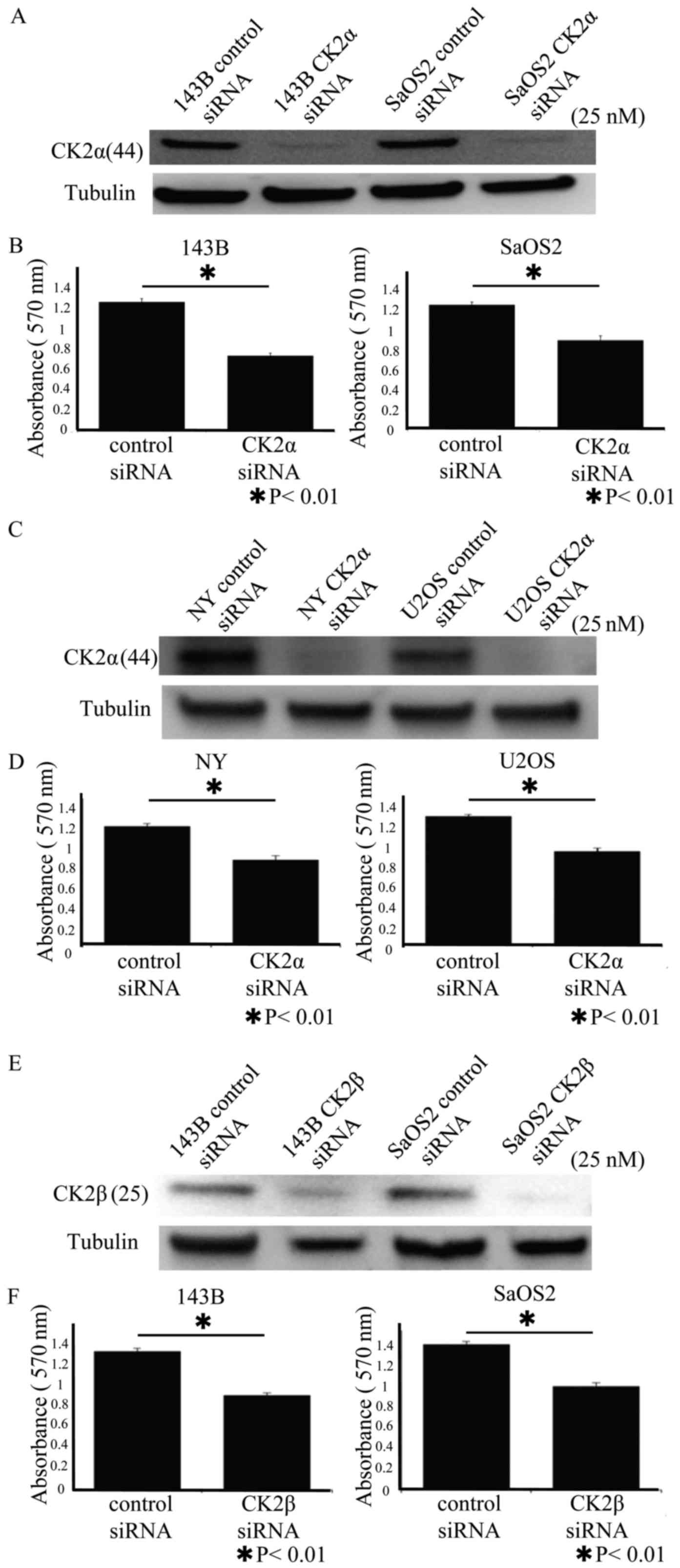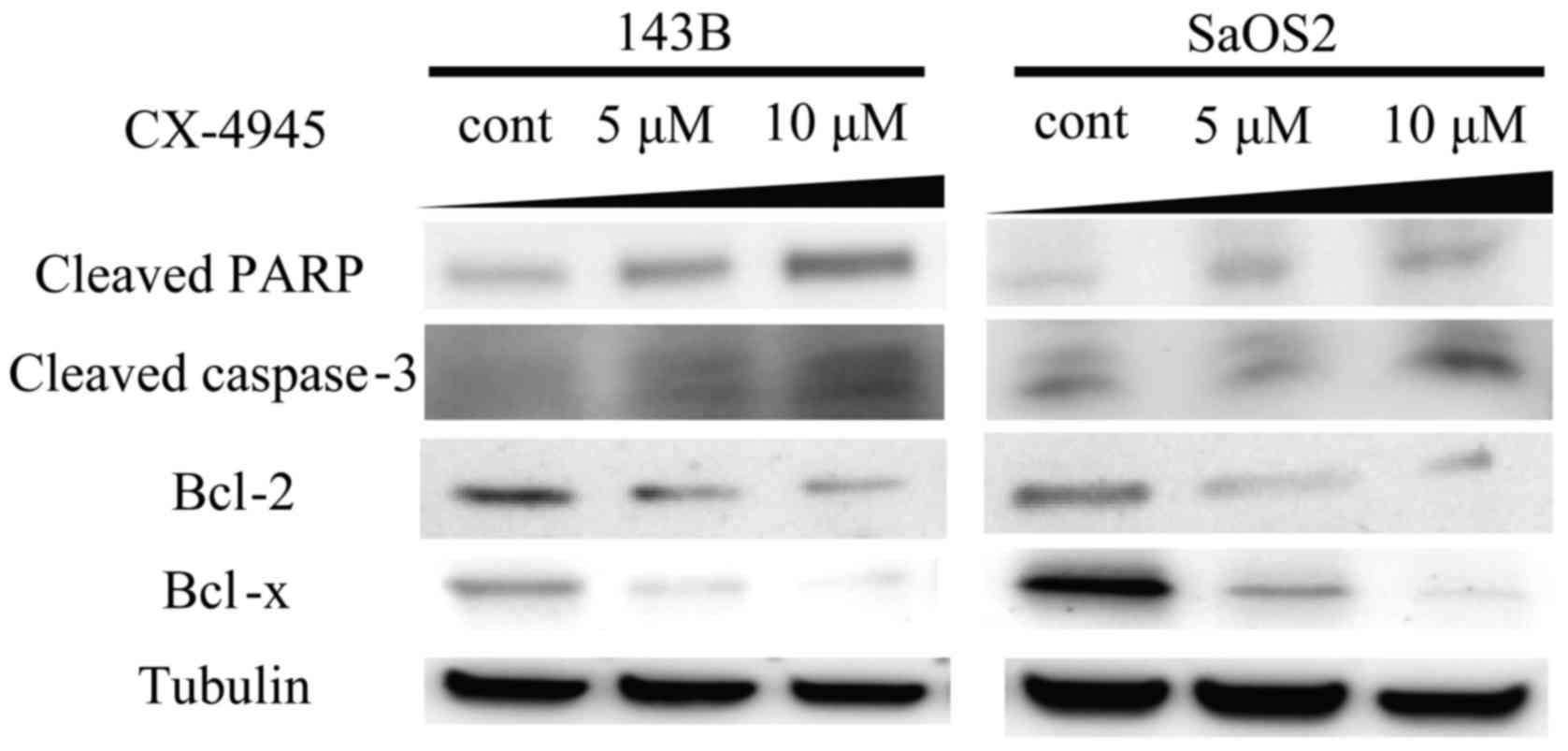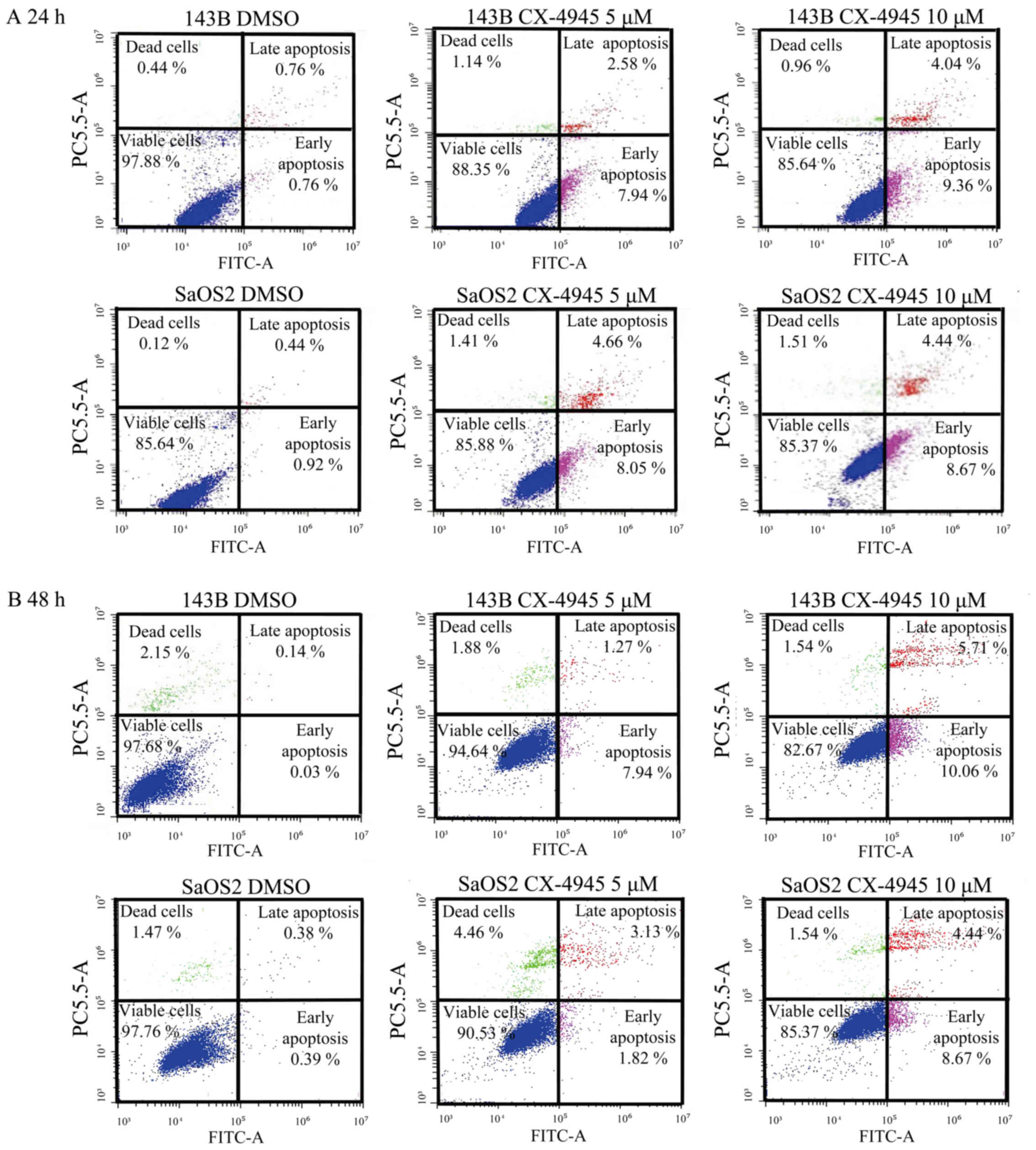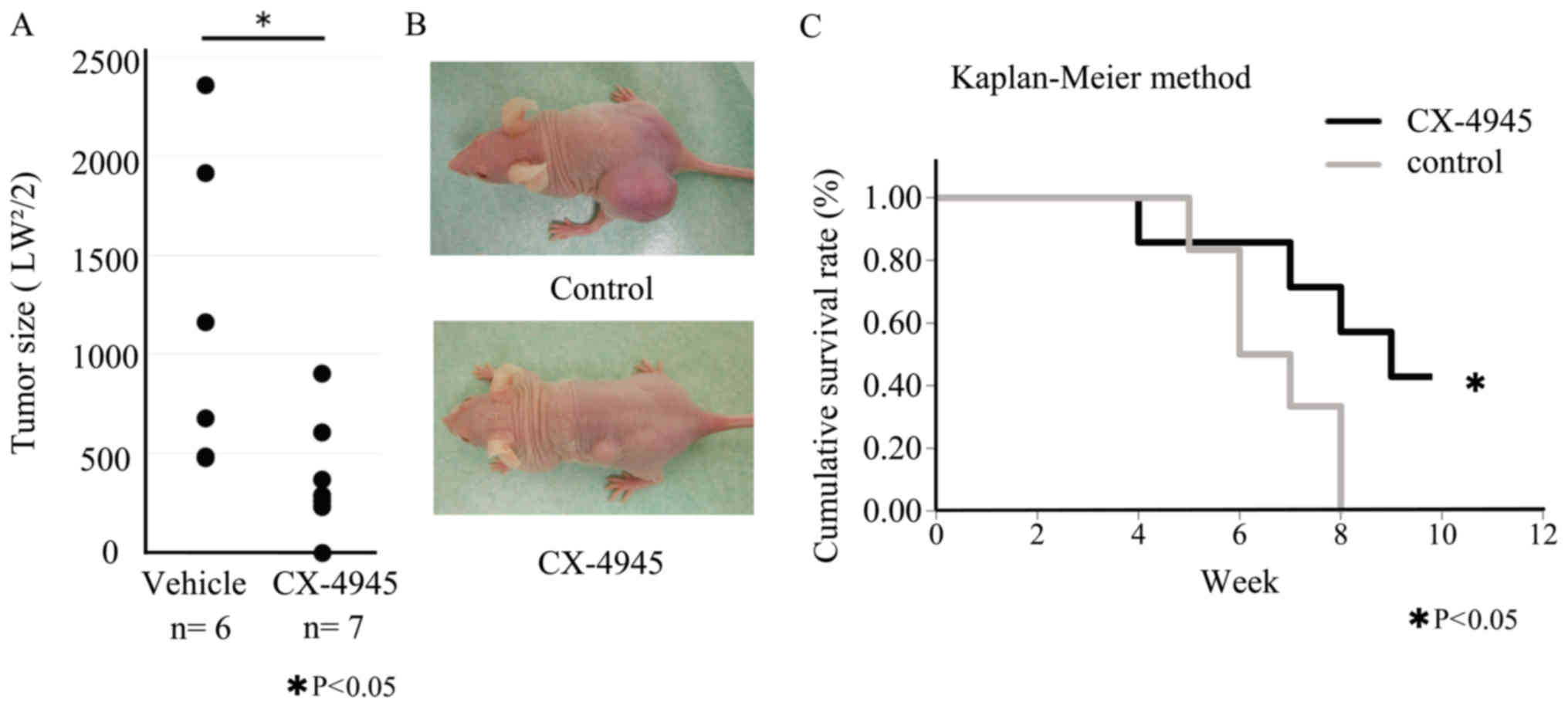Inhibition of casein kinase 2 prevents growth of human osteosarcoma
- Authors:
- Published online on: December 9, 2016 https://doi.org/10.3892/or.2016.5310
- Pages: 1141-1147
Abstract
Introduction
Osteosarcoma is the most common primary malignant bone tumor in children, adolescents, and young adults. Osteosarcoma has been treated using various chemotherapy regimens that have been developed over more than 40 years (1). Approximately 20% of patients with osteosarcoma develop metastases. More than 85% of metastatic disease occurs in the lung, which is the most common site of metastasis (2). Metastatic osteosarcoma exhibits resistance to chemotherapeutic treatment (3). There has been little improvement in the survival rates of osteosarcoma patients since the 1980s (1).
To improve the prognosis of osteosarcoma, many researchers have investigated molecular targets with which to inhibit osteosarcoma growth and metastasis. Casein kinase 2 (CK2) is a highly conserved serine/threonine kinase that comprises two α catalytic (α and α') and two β regulatory subunits (4). Hundreds of CK2 substrates have been identified, and many substrates continue to be discovered (5). CK2 has important roles in cell growth and cell fate. In addition, deregulated CK2 activation promotes many types of human cancers (6–9).
CX-4945 is a potent and selective orally bioavailable small molecule inhibitor of CK2 that has been investigated in clinical trials (10–14). CX-4945 promotes significant reductions in the proliferation and survival of non-small cell lung carcinoma, squamous cell carcinoma, breast cancer, pancreatic cancer, and B-cell lymphoma cells (10,15,16). In this study, we found that the expression of CK2 is upregulated in human osteosarcoma cells. We evaluated the function of CK2 in human osteosarcoma using siRNA and CX-4945.
Materials and methods
Cell lines and reagents
The human osteosarcoma cell lines 143B, SaOS-2, U2OS, and MG63 were purchased from the American Type Culture Collection (Manassas, VA, USA). The human osteosarcoma cell lines NY and Hu09 were purchased from the Health Science Research Resources Bank (Osaka, Japan). The human osteosarcoma cell lines NOS1 and HSOS1 were purchased from Riken Cell Bank (Tsukuba, Japan). Normal human osteoblast cells (NHost) were purchased from Sanko Junyaku (Tokyo, Japan). The human mesenchymal stem cell line UBE6T15 was purchased from Health Science Research Resources Bank. The cell lines were cultured at 37°C in 5% CO2. CX-4945 was purchased from MedChem Express (Princeton, NJ, USA). Control siRNA, CK2α siRNA, and CK2β siRNA were purchased from Dharmacon (Pittsburgh, PA, USA).
Analysis of cell viability
Cells were treated with CX-4945 and a control vehicle. Cell viability was evaluated by a WST-1 assay (Roche, Basel, Switzerland) for mitochondrial dehydrogenase activity, as described previously (17).
Western blot analysis
Cells were lysed using Mammalian Protein Extraction Reagent (Thermo Scientific, Waltham, MA, USA), 3 mM pAPMSF (Wako Chemicals, Kanagawa, Japan), 5 mg/ml aprotinin (Sigma-Aldrich, St. Louis, MO, USA), and 2 mM sodium orthovanadate (Wako Chemicals). SDS-PAGE and immunoblotting were performed, and the following antibodies were used: CK2α (Merck Millipore, Billerica, MA, USA), CK2β (Merck Millipore), cleaved-PARP (Cell Signaling, Danvers, MA, USA), cleaved caspase-3 (Cell Signaling), Bcl-xL (Cell Signaling), Bcl-2 (Cell Signaling), and tubulin (Sigma-Aldrich). ECL Western Blotting Reagent (GE Healthcare, Amersham, UK).
Flow cytometry
143B and Saos-2 were cultured with CX4945 or vehicle at 37°C in 5% CO2 for 24 and 48 h. Cells were treated with the Annexin V-FITC/7-AAD kit (Beckman Coulter, Brea, CA, USA), and fluorescence-activated cell sorting was performed with a CyAn ADP analyzer (Beckman Coulter).
Animal studies
Mouse xenograft models were created as previously described (17,18). For CX-4945 and control vehicle treatment, 143B cells (1×106) were suspended in 100 µl of Matrigel (BD Biosciences, Franklin Lakes, NJ, USA). Five-week-old nude mice were subcutaneously inoculated with the mixture of 143B cells and Matrigel. The tumor volume was evaluated using the formula LW2/2, where L and W represent the length and width of the tumor, respectively. Xenograft models were randomly treated with either CX-4945 (150 mg/kg/day) or an equal volume of vehicle as a control administered via oral tube every day. All animal experiments were performed in compliance with the guidelines of the Institute of Laboratory Animal Sciences, Graduate School of Medical and Dental Sciences, Kagoshima University (permit no. MD15045). Every effort was employed to minimize both the number of animals used and animal pain.
Statistical analysis
The Kolmogorov-Smirnov test was performed to examine the distribution of data. Statistical analyses were performed using the Mann-Whitney U test. The survival rate was evaluated using the Kaplan-Meier method and the log-rank test. All statistical analyses were performed using BellCurve for Excel 2015 (SSRI, Osaka, Japan). P<0.05 was considered statistically significant.
Results
Upregulated expression of CK2 in human osteosarcoma cells
Western blot analysis showed that the expression of both CK2α and CK2β protein was upregulated compared with NHost normal human osteoblasts and UBE6T15 human mesenchymal stem cells (Fig. 1).
Knockdown of CK2α or CK2β inhibited the proliferation of human osteosarcoma cells
We used siRNA to determine whether CK2α promoted the proliferation of osteosarcoma cells. Western blot analysis revealed that CK2α siRNA decreased the expression level of CK2α protein (Fig. 2A and C). WST assay revealed that knockdown of CK2α inhibited the proliferation of the 143B, SaOS-2, NY, and U2OS human osteosarcoma cell lines (Fig. 2B and D). In addition, we used siRNA to determine whether CK2β promoted the proliferation of osteosarcoma cells. Western blot analysis revealed that CK2β siRNA decreased the expression of CK2β protein (Fig. 2E). WST assay revealed that knockdown of CK2β inhibited the proliferation of the 143B and SaOS-2 human osteosarcoma cell lines (Fig. 2F).
CX-4945 inhibited the proliferation of human osteosarcoma cell lines, but not the proliferation of mesenchymal stem cells
We used 4 human osteosarcoma cell lines, 143B, SaOS2, NY, and U2OS which expressed high levels of CK2α for further examinations. Treatment with 3 µM CX-4945 did not inhibit the proliferation of UBE6T15 human mesenchymal stem cells (Fig. 3A); however, treatment with 3 µM CX-4945 caused a significant reduction in osteosarcoma cell proliferation. (Fig. 3B). WST assay revealed that treatment with CX-4945 inhibited the proliferation of the 143B, Saos-2, NY, and U2OS human osteosarcoma cell lines in a dose-dependent manner (Fig. 3C).
CX-4945 promotes apoptotic cell death of human osteosarcoma cell lines
Western blot analysis revealed that treatment with CX-4945 increased the expression of cleaved PARP and cleaved caspase-3 (Fig. 4). Treatment with CX-4945 also decreased the expression of Bcl-2 and Bcl-xL. Analysis by flow cytometry showed that treatment with CX-4945 increased the population of early and late apoptotic cells in 143B and SaOS-2 osteosarcoma cells at 24 and 48 h (Fig. 5). These findings indicate that CX-4945 treatment promoted apoptotic death of human osteosarcoma cells.
CX-4945 prevents osteosarcoma growth in vivo
Palpable tumors were confirmed in nude mice 7 days after inoculation with 143B osteosarcoma cells. Compared with control vehicle treatment, treatment with CX-4945 significantly inhibited the growth of the osteosarcoma xenografts (Fig. 6A). Kaplan-Meier analysis showed that CX-4945 treatment provided a significant survival benefit (Fig. 6B).
Discussion
CK2 is upregulated in many types of malignant tumors, and maintains the phenotype of malignancy (6,19). CK2 is a potential therapeutic target for human cancers, and has been tested in clinical trials (10–14). We found that human osteosarcoma cells upregulated the expression of CK2α and CK2β. To the best of our knowledge, this is the first report to show the upregulation of CK2 in human osteosarcoma. We showed that treatment with 3 µM CX-4945 inhibited osteosarcoma growth in vitro, but did not inhibit mesenchymal stem cell proliferation. These findings suggest that 3 µM of CX-4945 might be a safe and effective dose for osteosarcoma treatment. We also showed that CX-4945 prevented the growth of osteosarcoma in vivo.
CX-4945 reportedly has a long half-life, high oral bioavailability, and non-cardiac toxicity (20). Furthermore, CX-4945 inhibits osteoclast differentiation and enhances osteoblast differentiation (21), indicating that CX-4945 inhibits osteosarcoma growth while promoting the regeneration of affected bone. As CK2 reportedly drives the metastatic development of lung cancer, prostate cancer, squamous cell carcinoma, and breast carcinoma (9,22–25), the CK2 inhibitor CX-4945 is a promising drug for the treatment of metastatic bone tumors.
Human osteosarcoma specimens and cell lines reportedly have an overexpression of Hedgehog pathway-related genes, including SMO and GLI2. Furthermore, inhibition of the Hedgehog pathway prevents osteosarcoma growth and metastasis (17,18,26–30). CK2 activates the Hedgehog pathway in many types of cells, including mesothelioma, ovarian cancer, hepatocellular carcinoma, and lung cancer cells (31–36). There is a possibility that CX-4945 inhibits the Hedgehog pathway via inhibition of CK2. Osteosarcoma growth is inhibited in vitro by a combination of arsenic trioxide, a Hedgehog signal inhibitor, with conventional FDA-approved anticancer agents including cisplatin, ifosfamide, or doxorubicin. In vivo tumors treated with a combination of arsenic trioxide with either cisplatin or ifosfamide grew significantly less than tumors treated with the vehicle alone (17,27,29). These findings suggest that combining CX-4945 with conventional anticancer agents might more effectively prevent osteosarcoma growth, and that this combination therapy might decrease the required concentration of each drug. The lower levels of each agent in these combinations might reduce the toxicities associated with the use of each single drug. However, osteosarcoma is an extremely heterogeneous tumor. Preselection of patients with osteosarcoma exhibiting upregulated CK2 is required for CK2-targeted treatment.
CX-4945 reportedly modulates not only CK2 activity, but also PI3K-Akt-mTOR signaling, the Notch pathway, the PI3K-Akt-mTOR pathway, the focal adhesion kinase-Src-paxillin signaling cascade, ER stress signaling, NF-κB, and Bcl-xL, ERK, AP-1, and IL-8 gene activities (37–42). The pleotropic effect of CX-4945 and off-target effects of CK2 might potentially affect the inhibition of osteosarcoma growth. Nonetheless, CX-4945 showed promising therapeutic efficacy for osteosarcoma in this study.
Taken together, our findings indicate that CK2 might be an attractive therapeutic target, and that CX-4945 might be a promising new reagent for the treatment of osteosarcoma.
Acknowledgements
We are grateful to Hui Gao for her excellent technical assistance. We wish to thank the joint research laboratory of Kagoshima University Graduate School of Medical and Dental Sciences. This study was supported by Grants-in-Aid for Scientific Research (KAKENHI) (C) 19591725, (C) 20591786, (C) 21591919, (C) 21591920, (C) 22591663, (C) 23592195, and (C) 16K10868.
References
|
Isakoff MS, Bielack SS, Meltzer P and Gorlick R: Osteosarcoma: Current treatment and a collaborative pathway to success. J Clin Oncol. 33:3029–3035. 2015. View Article : Google Scholar : PubMed/NCBI | |
|
Bielack SS, Kempf-Bielack B, Delling G, Exner GU, Flege S, Helmke K, Kotz R, Salzer-Kuntschik M, Werner M, Winkelmann W, et al: Prognostic factors in high-grade osteosarcoma of the extremities or trunk: An analysis of 1,702 patients treated on neoadjuvant cooperative osteosarcoma study group protocols. J Clin Oncol. 20:776–790. 2002. View Article : Google Scholar : PubMed/NCBI | |
|
He JP, Hao Y, Wang XL, Yang XJ, Shao JF, Guo FJ and Feng JX: Review of the molecular pathogenesis of osteosarcoma. Asian Pac J Cancer Prev. 15:5967–5976. 2014. View Article : Google Scholar : PubMed/NCBI | |
|
Hanif IM, Hanif IM, Shazib MA, Ahmad KA and Pervaiz S: Casein Kinase II: An attractive target for anti-cancer drug design. Int J Biochem Cell Biol. 42:1602–1605. 2010. View Article : Google Scholar : PubMed/NCBI | |
|
Meggio F and Pinna LA: One-thousand-and-one substrates of protein kinase CK2? FASEB J. 17:349–368. 2003. View Article : Google Scholar : PubMed/NCBI | |
|
Ahmad KA, Harris NH, Johnson AD, Lindvall HC, Wang G and Ahmed K: Protein kinase CK2 modulates apoptosis induced by resveratrol and epigallocatechin-3-gallate in prostate cancer cells. Mol Cancer Ther. 6:1006–1012. 2007. View Article : Google Scholar : PubMed/NCBI | |
|
Faust RA, Gapany M, Tristani P, Davis A, Adams GL and Ahmed K: Elevated protein kinase CK2 activity in chromatin of head and neck tumors: Association with malignant transformation. Cancer Lett. 101:31–35. 1996. View Article : Google Scholar : PubMed/NCBI | |
|
Kim JS, Eom JI, Cheong JW, Choi AJ, Lee JK, Yang WI and Min YH: Protein kinase CK2alpha as an unfavorable prognostic marker and novel therapeutic target in acute myeloid leukemia. Clin Cancer Res. 13:1019–1028. 2007. View Article : Google Scholar : PubMed/NCBI | |
|
Liu Y, Amin EB, Mayo MW, Chudgar NP, Bucciarelli PR, Kadota K, Adusumilli PS and Jones DR: CK2α drives lung cancer metastasis by targeting BRMS1 nuclear export and degradation. Cancer Res. 76:2675–2686. 2016. View Article : Google Scholar : PubMed/NCBI | |
|
Siddiqui-Jain A, Drygin D, Streiner N, Chua P, Pierre F, O'Brien SE, Bliesath J, Omori M, Huser N, Ho C, et al: CX-4945, an orally bioavailable selective inhibitor of protein kinase CK2, inhibits prosurvival and angiogenic signaling and exhibits antitumor efficacy. Cancer Res. 70:10288–10298. 2010. View Article : Google Scholar : PubMed/NCBI | |
|
Ferguson AD, Sheth PR, Basso AD, Paliwal S, Gray K, Fischmann TO and Le HV: Structural basis of CX-4945 binding to human protein kinase CK2. FEBS Lett. 585:104–110. 2011. View Article : Google Scholar : PubMed/NCBI | |
|
Cozza G, Pinna LA and Moro S: Protein kinase CK2 inhibitors: A patent review. Expert Opin Ther Pat. 22:1081–1097. 2012. View Article : Google Scholar : PubMed/NCBI | |
|
Kim J and Kim SH: Druggability of the CK2 inhibitor CX-4945 as an anticancer drug and beyond. Arch Pharm Res. 35:1293–1296. 2012. View Article : Google Scholar : PubMed/NCBI | |
|
Sarno S, Papinutto E, Franchin C, Bain J, Elliott M, Meggio F, Kazimierczuk Z, Orzeszko A, Zanotti G, Battistutta R, et al: ATP site-directed inhibitors of protein kinase CK2: An update. Curr Top Med Chem. 11:1340–1351. 2011. View Article : Google Scholar : PubMed/NCBI | |
|
Bettendorff L, Wirtzfeld B, Makarchikov AF, Mazzucchelli G, Frédérich M, Gigliobianco T, Gangolf M, De Pauw E, Angenot L and Wins P: Discovery of a natural thiamine adenine nucleotide. Nat Chem Biol. 3:211–212. 2007. View Article : Google Scholar : PubMed/NCBI | |
|
Pizzi M, Piazza F, Agostinelli C, Fuligni F, Benvenuti P, Mandato E, Casellato A, Rugge M, Semenzato G and Pileri SA: Protein kinase CK2 is widely expressed in follicular, Burkitt and diffuse large B-cell lymphomas and propels malignant B-cell growth. Oncotarget. 6:6544–6552. 2015. View Article : Google Scholar : PubMed/NCBI | |
|
Nakamura S, Nagano S, Nagao H, Ishidou Y, Yokouchi M, Abematsu M, Yamamoto T, Komiya S and Setoguchi T: Arsenic trioxide prevents osteosarcoma growth by inhibition of GLI transcription via DNA damage accumulation. PLoS One. 8:e694662013. View Article : Google Scholar : PubMed/NCBI | |
|
Nagao H, Ijiri K, Hirotsu M, Ishidou Y, Yamamoto T, Nagano S, Takizawa T, Nakashima K, Komiya S and Setoguchi T: Role of GLI2 in the growth of human osteosarcoma. J Pathol. 224:169–179. 2011. View Article : Google Scholar : PubMed/NCBI | |
|
Kulbe H, Iorio F, Chakravarty P, Milagre CS, Moore R, Thompson RG, Everitt G, Canosa M, Montoya A, Drygin D, et al: Integrated transcriptomic and proteomic analysis identifies protein kinase CK2 as a key signaling node in an inflammatory cytokine network in ovarian cancer cells. Oncotarget. 7:15648–15661. 2016.PubMed/NCBI | |
|
Son YH, Song JS, Kim SH and Kim J: Pharmacokinetic characterization of CK2 inhibitor CX-4945. Arch Pharm Res. 36:840–845. 2013. View Article : Google Scholar : PubMed/NCBI | |
|
Son YH, Moon SH and Kim J: The protein kinase 2 inhibitor CX-4945 regulates osteoclast and osteoblast differentiation in vitro. Mol Cells. 36:417–423. 2013. View Article : Google Scholar : PubMed/NCBI | |
|
Trembley JH, Unger GM, Korman VL, Abedin MJ, Nacusi LP, Vogel RI, Slaton JW, Kren BT and Ahmed K: Tenfibgen ligand nanoencapsulation delivers bi-functional anti-CK2 RNAi oligomer to key sites for prostate cancer targeting using human xenograft tumors in mice. PLoS One. 9:e1099702014. View Article : Google Scholar : PubMed/NCBI | |
|
Unger GM, Kren BT, Korman VL, Kimbrough TG, Vogel RI, Ondrey FG, Trembley JH and Ahmed K: Mechanism and efficacy of sub-50-nm tenfibgen nanocapsules for cancer cell-directed delivery of anti-CK2 RNAi to primary and metastatic squamous cell carcinoma. Mol Cancer Ther. 13:2018–2029. 2014. View Article : Google Scholar : PubMed/NCBI | |
|
Giusiano S, Cochet C, Filhol O, Duchemin-Pelletier E, Secq V, Bonnier P, Carcopino X, Boubli L, Birnbaum D, Garcia S, et al: Protein kinase CK2α subunit over-expression correlates with metastatic risk in breast carcinomas: Quantitative immunohistochemistry in tissue microarrays. Eur J Cancer. 47:792–801. 2011. View Article : Google Scholar : PubMed/NCBI | |
|
Gapany M, Faust RA, Tawfic S, Davis A, Adams GL and Ahmed K: Association of elevated protein kinase CK2 activity with aggressive behavior of squamous cell carcinoma of the head and neck. Mol Med. 1:659–666. 1995.PubMed/NCBI | |
|
Yang W, Liu X, Choy E, Mankin H, Hornicek FJ and Duan Z: Targeting hedgehog-GLI-2 pathway in osteosarcoma. J Orthop Res. 31:502–509. 2013. View Article : Google Scholar : PubMed/NCBI | |
|
Saitoh Y, Setoguchi T, Nagata M, Tsuru A, Nakamura S, Nagano S, Ishidou Y, Nagao-Kitamoto H, Yokouchi M, Maeda S, et al: Combination of Hedgehog inhibitors and standard anticancer agents synergistically prevent osteosarcoma growth. Int J Oncol. 48:235–242. 2016.PubMed/NCBI | |
|
Nagao-Kitamoto H, Setoguchi T, Kitamoto S, Nakamura S, Tsuru A, Nagata M, Nagano S, Ishidou Y, Yokouchi M, Kitajima S, et al: Ribosomal protein S3 regulates GLI2-mediated osteosarcoma invasion. Cancer Lett 356B. 855–861. 2015. View Article : Google Scholar | |
|
Nagao-Kitamoto H, Nagata M, Nagano S, Kitamoto S, Ishidou Y, Yamamoto T, Nakamura S, Tsuru A, Abematsu M, Fujimoto Y, et al: GLI2 is a novel therapeutic target for metastasis of osteosarcoma. Int J Cancer. 136:1276–1284. 2015. View Article : Google Scholar : PubMed/NCBI | |
|
Hirotsu M, Setoguchi T, Sasaki H, Matsunoshita Y, Gao H, Nagao H, Kunigou O and Komiya S: Smoothened as a new therapeutic target for human osteosarcoma. Mol Cancer. 9:52010. View Article : Google Scholar : PubMed/NCBI | |
|
Zhang S, Yang YL, Wang Y, You B, Dai Y, Chan G, Hsieh D, Kim IJ, Fang LT, Au A, et al: CK2α, over-expressed in human malignant pleural mesothelioma, regulates the Hedgehog signaling pathway in mesothelioma cells. J Exp Clin Cancer Res. 33:932014. View Article : Google Scholar : PubMed/NCBI | |
|
Tang AQ, Cao XC, Tian L, He L and Liu F: Apigenin inhibits the self-renewal capacity of human ovarian cancer SKOV3-derived sphere-forming cells. Mol Med Rep. 11:2221–2226. 2015.PubMed/NCBI | |
|
Wu D, Sui C, Meng F, Tian X, Fu L, Li Y, Qi X, Cui H, Liu Y and Jiang Y: Stable knockdown of protein kinase CK2-alpha (CK2α) inhibits migration and invasion and induces inactivation of hedgehog signaling pathway in hepatocellular carcinoma Hep G2 cells. Acta Histochem. 116:1501–1508. 2014. View Article : Google Scholar : PubMed/NCBI | |
|
Zhang S, Wang Y, Mao JH, Hsieh D, Kim IJ, Hu LM, Xu Z, Long H, Jablons DM and You L: Inhibition of CK2α down-regulates Hedgehog/Gli signaling leading to a reduction of a stem-like side population in human lung cancer cells. PLoS One. 7:e389962012. View Article : Google Scholar : PubMed/NCBI | |
|
Jin Z, Mei W, Strack S, Jia J and Yang J: The antagonistic action of B56-containing protein phosphatase 2As and casein kinase 2 controls the phosphorylation and Gli turnover function of Daz interacting protein 1. J Biol Chem. 286:36171–36179. 2011. View Article : Google Scholar : PubMed/NCBI | |
|
Jia H, Liu Y, Xia R, Tong C, Yue T, Jiang J and Jia J: Casein kinase 2 promotes Hedgehog signaling by regulating both smoothened and Cubitus interruptus. J Biol Chem. 285:37218–37226. 2010. View Article : Google Scholar : PubMed/NCBI | |
|
Kim J, Choi WJ, Moon SH, Jung J, Park JK, Kim SH and Lee JO: Micropillar arrays as potential drug screens: Inhibition of micropillar-mediated activation of the FAK-Src-paxillin signaling pathway by the CK2 inhibitor CX-4945. Acta Biomater. 27:13–20. 2015. View Article : Google Scholar : PubMed/NCBI | |
|
Bian Y, Han J, Kannabiran V, Mohan S, Cheng H, Friedman J, Zhang L, VanWaes C and Chen Z: MEK inhibitor PD-0325901 overcomes resistance to CK2 inhibitor CX-4945 and exhibits anti-tumor activity in head and neck cancer. Int J Biol Sci. 11:411–422. 2015. View Article : Google Scholar : PubMed/NCBI | |
|
Intemann J, Saidu NE, Schwind L and Montenarh M: ER stress signaling in ARPE-19 cells after inhibition of protein kinase CK2 by CX-4945. Cell Signal. 26:1567–1575. 2014. View Article : Google Scholar : PubMed/NCBI | |
|
Zhang S, Long H, Yang YL, Wang Y, Hsieh D, Li W, Au A, Stoppler HJ, Xu Z, Jablons DM, et al: Inhibition of CK2α down-regulates Notch1 signalling in lung cancer cells. J Cell Mol Med. 17:854–862. 2013. View Article : Google Scholar : PubMed/NCBI | |
|
Bliesath J, Huser N, Omori M, Bunag D, Proffitt C, Streiner N, Ho C, Siddiqui-Jain A, O'Brien SE, Lim JK, et al: Combined inhibition of EGFR and CK2 augments the attenuation of PI3K-Akt-mTOR signaling and the killing of cancer cells. Cancer Lett. 322:113–118. 2012. View Article : Google Scholar : PubMed/NCBI | |
|
Martins LR, Lúcio P, Melão A, Antunes I, Cardoso BA, Stansfield R, Bertilaccio MT, Ghia P, Drygin D, Silva MG, et al: Activity of the clinical-stage CK2-specific inhibitor CX-4945 against chronic lymphocytic leukemia. Leukemia. 28:179–182. 2014. View Article : Google Scholar : PubMed/NCBI |















